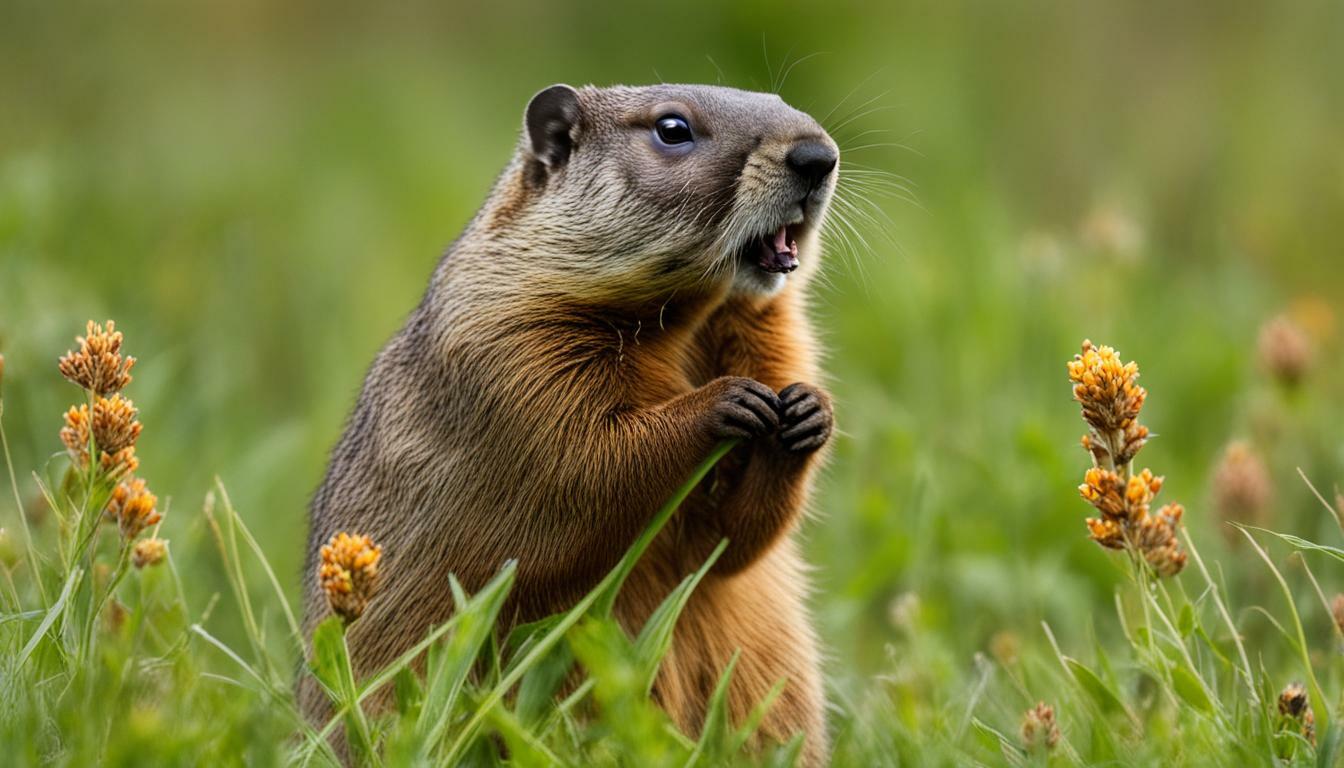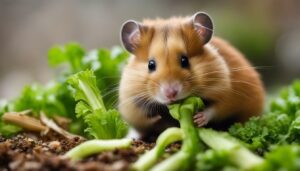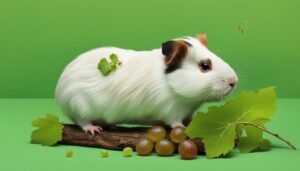Groundhogs are known for their voracious appetite and curiosity about various plants, including milkweed. These creatures have been observed exploring flower beds and gardens, often nibbling on a variety of plants. While they primarily have a herbivorous diet, groundhogs occasionally indulge in small insects and animals.
Milkweed, in particular, seems to be a favorite among groundhogs. However, they are not the only ones who appreciate this plant. Other animals, such as deer and rabbits, also enjoy munching on milkweed leaves. Insects like the milkweed bug and queen butterfly larva also find milkweed to be a delightful food source.
Interestingly, although milkweed is toxic to pets and livestock, groundhogs have developed a tolerance to its toxins. Their bodies can handle the chemicals found in milkweed without any ill effects. This unique ability allows them to include milkweed in their diet without suffering any harm.
If you’re looking to protect your garden from groundhog damage, consider planting groundhog-resistant plants. Daffodils, scented ornamentals, and herbs like mint and lavender are excellent choices that these creatures are less likely to eat. Additionally, vegetables like onion and fennel can help deter groundhogs from feasting on your garden.
Key Takeaways:
- Groundhogs have a strong appetite for various plants, including milkweed.
- Milkweed is also favored by other animals and insects.
- Although toxic to pets and livestock, groundhogs can tolerate milkweed toxins.
- Planting groundhog-resistant plants can help protect your garden.
- Consider daffodils, scented ornamentals, mint, lavender, onion, and fennel as groundhog-resistant options.
Understanding Groundhog Diets
Groundhogs are primarily herbivores and enjoy munching on a variety of plants. They have a voracious appetite and can be quite destructive to flower beds and gardens. While their exact food preferences may vary, groundhogs commonly indulge in plants such as milkweed and black-eyed Susans.
Although groundhogs are mostly herbivorous, they occasionally incorporate small insects and animals into their diet. This means that while your garden may be their main target, they also have a taste for the occasional insect snack.
It is interesting to note that milkweed, a plant commonly associated with monarch butterflies, is also loved by groundhogs. However, this plant is toxic to pets and livestock. Groundhogs, on the other hand, have developed a tolerance to the toxins found in milkweed, allowing them to safely consume it. This makes milkweed a popular choice for not only groundhogs but also other animals such as deer, rabbits, milkweed bugs, and queen butterfly larvae.
| Groundhog-Resistant Plants | Description |
|---|---|
| Daffodils | Not favored by groundhogs due to their toxic bulbs. |
| Scented Ornamentals | Strong-smelling flowers and herbs like mint and lavender can deter groundhogs from entering your garden. |
| Onions and Fennel | Groundhogs tend to avoid these strong-smelling vegetables. |
To minimize the damage caused by groundhogs in your garden, consider planting groundhog-resistant plants such as daffodils, scented ornamentals like mint and lavender, and vegetables like onion and fennel. These plants emit strong scents that groundhogs find off-putting, making them less likely to snack on your garden.
Milkweed in Groundhog Diets
Milkweed plants are among the many types of vegetation that groundhogs may consume. These herbivorous creatures have a diverse diet that includes various plants, and milkweed is no exception. While groundhogs are known to have a voracious appetite and will nibble on flower beds and gardens, their fondness for milkweed is worth noting.
Milkweed consumption by groundhogs is not uncommon, as these plants provide a source of nutrition for them. However, it is essential to understand that groundhogs do not rely solely on milkweed for sustenance. They also eat other plants, such as black-eyed Susans, as well as occasionally feeding on small insects and animals.
Milkweed’s Appeal to Other Creatures
Groundhogs are not the only ones who appreciate milkweed. Other animals, including deer and rabbits, are also fond of these plants. Additionally, milkweed serves as a crucial food source for insects like the milkweed bug and queen butterfly larva. Its vibrant flowers and nectar attract these creatures, making it an essential part of their life cycle.
While milkweed may be a valuable resource for other animals, it is important to note that it can be toxic to pets and livestock. However, groundhogs have developed a tolerance to the toxins present in milkweed, allowing them to consume it without adverse effects.
| Groundhog-Resistant Plants | Common Name |
|---|---|
| Daffodils | Narcissus |
| Scented Ornamentals | Lavandula |
| Herbs | Mint, Lavender |
| Vegetables | Onion, Fennel |
If you want to deter groundhogs from eating your garden, consider planting groundhog-resistant plants. Daffodils, scented ornamentals like lavender, and herbs such as mint and lavender are less likely to attract groundhogs. Additionally, vegetables like onion and fennel can also help protect your garden from these hungry critters.
By understanding the relationship between groundhogs and milkweed, you can make informed decisions about your garden. While groundhogs may enjoy nibbling on milkweed, there are ways to safeguard your plants and create a more harmonious environment for both humans and wildlife.
Groundhogs and Other Plants
While groundhogs do eat milkweed, they also have a diverse palate that includes various flowers and greens. These herbivores have been known to nibble on flower beds and gardens, causing frustration for garden enthusiasts. Apart from milkweed, groundhogs can be found indulging in other plants, such as the vibrant black-eyed Susans.
It is worth noting that groundhogs occasionally consume small insects and animals, adding a touch of protein to their primarily plant-based diet. However, their focus remains on feasting on greens and flowers. Groundhogs’ affinity for milkweed is not unique, as other animals like deer and rabbits are also drawn to its allure. Insects like the milkweed bug and queen butterfly larva also consider milkweed a favorite treat.
Interestingly, while milkweed is toxic to pets and livestock, groundhogs have developed a remarkable tolerance to its toxins. This allows them to enjoy this particular plant without any adverse effects. However, it’s essential to keep pets and livestock away from milkweed, as its toxicity can be harmful to them.
Planting Groundhog-Resistant Plants
To deter groundhogs from devouring your garden, it is recommended to plant groundhog-resistant plants. Options include daffodils, which these critters tend to avoid due to their strong scent. Scented ornamentals like mint and lavender are also effective deterrents. Additionally, groundhogs have a distaste for vegetables like onions and fennel, making them excellent choices for planting in your garden.
| Groundhog-Resistant Plants | Benefits |
|---|---|
| Daffodils | Strong scent repels groundhogs |
| Scented Ornamentals (Mint, Lavender) | Groundhogs dislike the strong fragrance |
| Onions | Groundhogs have a distaste for this vegetable |
| Fennel | Groundhogs are not fond of its taste |
Other Animals and Milkweed
Milkweed is a food source not only for groundhogs but also for deer, rabbits, and various insects. These animals are attracted to the sweet aroma and nectar that milkweed plants produce. For deer and rabbits, milkweed serves as a delicious treat, while insects like the milkweed bug and queen butterfly larvae rely on milkweed as their primary food source.
It is fascinating to observe how different animals interact with milkweed. The silky fibers of milkweed seeds are carried by the wind, helping the plant spread its seeds to new locations. In turn, this creates opportunities for more animals to discover and enjoy the benefits of milkweed.
However, it is important to note that while milkweed is a valuable food source for these animals, it can be toxic to pets and livestock. The toxins within milkweed can cause severe health issues and even be fatal to animals that are not adapted to tolerate them. Groundhogs, on the other hand, have developed a certain level of tolerance to these toxins, allowing them to safely consume milkweed as part of their diet.
| Animals | Preference for Milkweed |
|---|---|
| Groundhogs | Enjoy eating milkweed |
| Deer | Are attracted to milkweed’s sweet aroma |
| Rabbits | Consider milkweed a delicious treat |
| Milkweed bugs | Feed on milkweed as their primary food source |
| Queen butterfly larvae | Rely on milkweed exclusively for nutrition |
To protect your pets and livestock from the potential dangers of milkweed, it is best to keep them away from areas where milkweed grows. If you have a garden or flower bed that is accessible to groundhogs, consider planting groundhog-resistant plants instead. Daffodils, scented ornamentals, herbs like mint and lavender, and vegetables like onions and fennel are excellent choices that will deter groundhogs and help preserve your garden.
Groundhogs’ Tolerance to Milkweed Toxins
While milkweed is toxic to some animals, groundhogs have developed a remarkable ability to tolerate its toxins. These furry critters have a unique digestive system that allows them to safely consume milkweed without suffering any ill effects. In fact, milkweed is considered a favorite food of groundhogs, who happily munch on its leaves, stems, and even its flowers.
Unlike many other animals, groundhogs have evolved to metabolize the toxic compounds found in milkweed, including cardiac glycosides and alkaloids. These chemicals, which act as natural defenses for the milkweed plant, can be deadly to other creatures. However, groundhogs have adapted over time to safely process and eliminate these toxins from their bodies.
This remarkable tolerance to milkweed toxins allows groundhogs to thrive in areas where the plant is abundant. It also provides them with a valuable food source throughout the summer months when milkweed is in full bloom. Groundhogs’ ability to consume milkweed without harm demonstrates the fascinating adaptability of these animals and their unique relationship with the plant kingdom.
Table: Groundhog Tolerance to Milkweed Toxins
| Animals | Tolerance to Milkweed Toxins |
|---|---|
| Groundhogs | High tolerance |
| Deer | Low tolerance |
| Rabbits | Varies, some species can tolerate small amounts |
| Pets and Livestock | Toxic, should be avoided |
It is important to note that while groundhogs can safely eat milkweed, this does not mean the plant is harmless to all animals. Deer and rabbits, for example, may experience negative health effects if they consume large quantities. Additionally, milkweed is toxic to pets and livestock, so it should be avoided in areas where these animals have access to it.
To deter groundhogs from dining on your garden, consider planting groundhog-resistant plants. Daffodils, scented ornamentals, and herbs like mint and lavender are known to be less appealing to these critters. Vegetables such as onion and fennel can also help keep groundhogs at bay. By selecting these plants, you can create a garden that is more likely to thrive and less tempting to groundhogs.
Planting Groundhog-Resistant Plants
To protect your garden from groundhog munching, consider planting daffodils, scented ornamentals, herbs like mint and lavender, and vegetables like onion and fennel. These plants have properties that make them less appealing to groundhogs, reducing the likelihood of your garden being damaged. Daffodils, for instance, have a bitter taste that groundhogs dislike, while scented ornamentals emit fragrances that may deter them.
Mint and lavender are known for their strong scents, which can mask the enticing aroma of other plants, making them less attractive to groundhogs. Additionally, groundhogs tend to avoid onion and fennel due to their pungent flavors. Planting these herbs and vegetables strategically throughout your garden can create a natural barrier that discourages groundhogs from feasting on your plants.
Groundhog-Resistant Plants
If you’re looking to expand your garden with groundhog-resistant plants, here is a list to consider:
| Plant | Reason |
|---|---|
| Daffodils | Bitter taste |
| Scented ornamentals | Fragrant deterrent |
| Mint | Strong scent |
| Lavender | Strong scent |
| Onion | Pungent flavor |
| Fennel | Pungent flavor |
By incorporating these groundhog-resistant plants into your garden, you can help safeguard your precious plants from groundhog foraging. Remember to observe your garden regularly and take necessary measures to prevent damage, such as installing fences or using natural repellents if needed. With a little planning and the right selection of plants, you can create a beautiful garden that remains unappealing to groundhogs.
Groundhogs’ Impact on Gardens
Groundhogs’ appetites can pose a challenge to gardeners, as they tend to nibble on flower beds and vegetable patches. These voracious herbivores have been known to cause significant damage to gardens, resulting in frustration for those who put time and effort into cultivating their plants.
When it comes to plants, groundhogs do not discriminate. They will happily munch on various types of vegetation, including flowers, vegetables, and herbs. This includes beloved garden staples like tomatoes, lettuce, and carrots. Their feeding habits can quickly turn a beautiful garden into a disheveled mess.
While groundhogs primarily have a plant-based diet, they do occasionally supplement it with small insects and animals. However, it is their affinity for plants that tends to cause the most trouble for gardeners. You may be surprised to learn that groundhogs have a particular fondness for black-eyed Susans, a popular and vibrant flower found in many gardens.
Groundhog-Resistant Plants
| Groundhog-Resistant Plants | Type |
|---|---|
| Daffodils | Flower |
| Scented ornamentals | Flower |
| Mint | Herb |
| Lavender | Herb |
| Onion | Vegetable |
| Fennel | Vegetable |
To minimize the damage caused by groundhogs, consider planting groundhog-resistant plants. Daffodils, with their vibrant yellow blooms, are a great choice as they are toxic to groundhogs. Scented ornamentals not only add fragrance to your garden but also deter groundhogs with their strong scents. Herbs like mint and lavender are known to repel these garden invaders, while vegetables such as onion and fennel are less likely to be on a groundhog’s menu.
By incorporating these plants into your garden, you can create a barrier that discourages groundhogs from feasting on your prized flowers and vegetables. Remember, prevention is key when it comes to managing groundhog damage, so be proactive in your garden management strategies to ensure your plants thrive.
Groundhogs and Small Insects
While groundhogs are primarily herbivores, they may also incorporate small insects and animals into their diet. These furry creatures have a voracious appetite and are known to nibble on flower beds and gardens. Although their main food sources consist of plants such as black-eyed Susans and milkweed, groundhogs occasionally indulge in protein-rich snacks like small insects and animals.
It’s important to note that groundhogs are not true omnivores and their diet primarily consists of vegetation. However, when the opportunity arises, they will feed on small insects and animals to supplement their nutrient intake. This behavior allows groundhogs to acquire essential nutrients that may be lacking in their herbivorous diet.
By incorporating small insects and animals into their diet, groundhogs showcase their adaptability and ability to diversify their food sources. This behavior also highlights the importance of creating a balanced and varied diet for these animals. Groundhogs possess the natural instinct to seek out different food options in their environment, ensuring they meet their nutritional needs.
Groundhog Diet: A Summary
- Groundhogs are primarily herbivores, but will occasionally consume small insects and animals.
- They have a preference for plants like black-eyed Susans and milkweed.
- Milkweed is also favored by other animals, including deer, rabbits, and various insects.
- Groundhogs can tolerate the toxins present in milkweed, but it can be toxic to pets and livestock.
- To deter groundhogs from gardens, it is recommended to plant groundhog-resistant plants like daffodils, scented ornamentals, herbs such as mint and lavender, and vegetables like onion and fennel.
| Groundhog Diet | Summary |
|---|---|
| Primary Food Sources | Plants, including black-eyed Susans and milkweed |
| Occasional Food Sources | Small insects and animals |
| Preference for Milkweed | Shared with other animals, but toxic to pets and livestock |
| Groundhog-Resistant Plants | Daffodils, scented ornamentals, mint, lavender, onion, and fennel |
Groundhogs’ Love for Black-Eyed Susans
In addition to milkweed, groundhogs have a particular fondness for plants like black-eyed Susans. These vibrant flowers, with their bright yellow petals and dark centers, are a favorite treat for groundhogs. They are often found nibbling on the leaves and flowers of black-eyed Susans, adding a touch of color to their otherwise green diet.
Black-eyed Susans (scientifically known as Rudbeckia hirta) are a member of the sunflower family and are native to North America. They are hardy and easy to grow, making them a popular choice for gardens and flower beds. However, their appeal extends beyond human appreciation, as groundhogs also find them irresistible.
If you have black-eyed Susans in your garden, you may notice that groundhogs are particularly drawn to them. These furry creatures are known for their voracious appetite and can quickly make a meal out of your precious plants. While it can be frustrating to see your black-eyed Susans being nibbled on, there are ways to deter groundhogs and protect your flowers.
| Groundhog-Resistant Plants: | Description: |
|---|---|
| Daffodils | These bright, trumpet-shaped flowers are toxic to groundhogs and will keep them away from your garden. |
| Scented Ornamentals | Plants like lavender and mint have a strong scent that groundhogs find unpleasant, making them less likely to indulge in your garden. |
| Herbs | Groundhogs have an aversion to strong-smelling herbs like onion and fennel. Planting these in your garden can help deter them. |
By incorporating these groundhog-resistant plants into your garden, you can create a natural barrier that discourages groundhogs from feasting on your black-eyed Susans. Additionally, using fencing or netting can provide physical protection for your flowers.
Understanding groundhogs’ food preferences and taking preventive measures can help you maintain a beautiful garden while coexisting peacefully with these curious critters. With a little planning and the right selection of plants, you can enjoy the sight of black-eyed Susans blooming in your garden without worrying about them becoming a groundhog’s next meal.
Groundhogs and Garden Management
To strike a balance between allowing groundhogs to thrive and protecting your garden, implement strategies like fencing and natural deterrents. Groundhogs are known for their fondness for flower beds and gardens, making them a potential nuisance for gardeners. By taking proactive steps, you can create a garden that is less appealing to these furry visitors.
A reliable method to keep groundhogs out of your garden is by installing a sturdy fence. Opt for a wire fence that is buried about a foot deep to prevent groundhogs from digging underneath. Make sure the fence is at least four feet tall, as groundhogs are excellent climbers. Additionally, adding an electric wire at the top can provide an extra deterrent.
Natural deterrents
In addition to fencing, there are natural deterrents that can help deter groundhogs from your garden. One effective method is to use strong-smelling plants that groundhogs find unappealing. Plants like mint, lavender, and onion are known to repel these critters due to their pungent aroma. Consider planting them around the perimeter of your garden or interspersed with your other plants to create a natural barrier.
Another natural option is to use repellents that contain predator urine, like fox or coyote urine. These scents can trick groundhogs into thinking there is a predator nearby, causing them to avoid your garden. Be sure to reapply the repellent regularly, especially after rain or if you notice a decrease in effectiveness.
| Groundhog-Resistant Plants | Characteristics |
|---|---|
| Daffodils | Have a bitter taste that deters groundhogs |
| Scented ornamentals | Strong fragrance acts as a natural repellent |
| Herbs like mint and lavender | Release strong scents that groundhogs dislike |
| Vegetables like onion and fennel | Have a pungent smell that repels groundhogs |
By incorporating these groundhog-resistant plants into your garden, you not only protect your plants but also create a visually appealing space. Remember to maintain your garden regularly, removing any fallen fruits or vegetables that could attract groundhogs.
Conclusion
Groundhogs are known to have a varied diet, including the consumption of milkweed, but they also enjoy other plants and occasionally feed on small insects and animals. These adorable creatures have a voracious appetite and can cause damage to your garden if not properly managed.
While groundhogs may nibble on flower beds and gardens, it is interesting to note that they have a particular fondness for milkweed plants. However, they are not the only ones who love this plant. Other animals, such as deer and rabbits, as well as insects like the milkweed bug and queen butterfly larva, are also attracted to milkweed.
It’s important to be aware that milkweed is toxic to pets and livestock, but groundhogs have developed a tolerance to its toxins. Therefore, if you have a groundhog problem in your garden, planting groundhog-resistant plants can be an effective solution. Consider incorporating daffodils, scented ornamentals, herbs like mint and lavender, and vegetables like onion and fennel into your garden, as these are less appealing to groundhogs.
By implementing these strategies, you can deter groundhogs from feasting on your precious plants and enjoy a beautiful garden without causing harm to these fascinating creatures.
FAQ
Do groundhogs eat milkweed?
Yes, groundhogs have been observed eating milkweed plants along with other plants such as black-eyed Susans.
What else do groundhogs eat?
Groundhogs are primarily herbivores but occasionally feed on small insects and animals.
Are there other animals that eat milkweed?
Yes, milkweed is also loved by other animals, including deer and rabbits, as well as insects like the milkweed bug and queen butterfly larva.
Can groundhogs tolerate the toxins in milkweed?
Yes, groundhogs can tolerate the toxins found in milkweed, unlike pets and livestock.
What plants are groundhog-resistant?
Daffodils, scented ornamentals, herbs like mint and lavender, and vegetables like onion and fennel are recommended to deter groundhogs from eating your garden.




